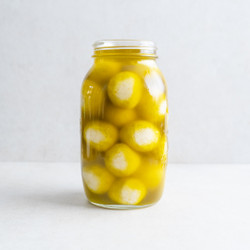Add the bulgur, salt and water to a clean 2l mason jar and stir to combine. Leave the bulgur to absorb the water for around 1 hour, then give it another stir.
Cover the jar with a cheesecloth, keep in a dark place (like the cupboard) and stir it daily for 4-6 weeks with a clean spoon to avoid any growth of fungus. For the first days, the bulgur will rise to the top, but after stirring and pressing it down, there should be enough water to cover the bulgur with a thin layer. If not, add a little bit more. After just a few days, bubbles will rise to the surface when you shake the jar or stir the bulgur, which is a sign the that fermentation has kicked in. A few days later, the bulgur will begin to break down and turn into a paste every time you stir it. You'll notice a white layer of yeasts developing on the surface of the bulgur, which is normal. By now, it should taste tangy and slightly cheesy and you can keep going until it develops a flavour you like. The time really depends on the ambient temperature and your preference.
Once it’s fermented to your liking, line a colander with cheesecloth and tip the bulgur into the cloth. Then use some butchers string to tie the cheesecloth closed and hang it from a height with a bowl placed underneath to catch any liquid (you can also tie it to the kitchen tap and let it drain into the sink). Let it drain overnight.
The next day, squeeze out more moisture if you can, then tip the paste into a bowl and use your hands to knead it as smooth as possible.
Shape the bulgur mixture into small balls. You can coat them with dried herbs, spices or seeds like sesame and nigella to add flavour. Store them in clean jars and cover them entirely with plenty of extra virgin olive oil. They can be eaten straight away but will develop more complexity over the next 4-6 weeks.
